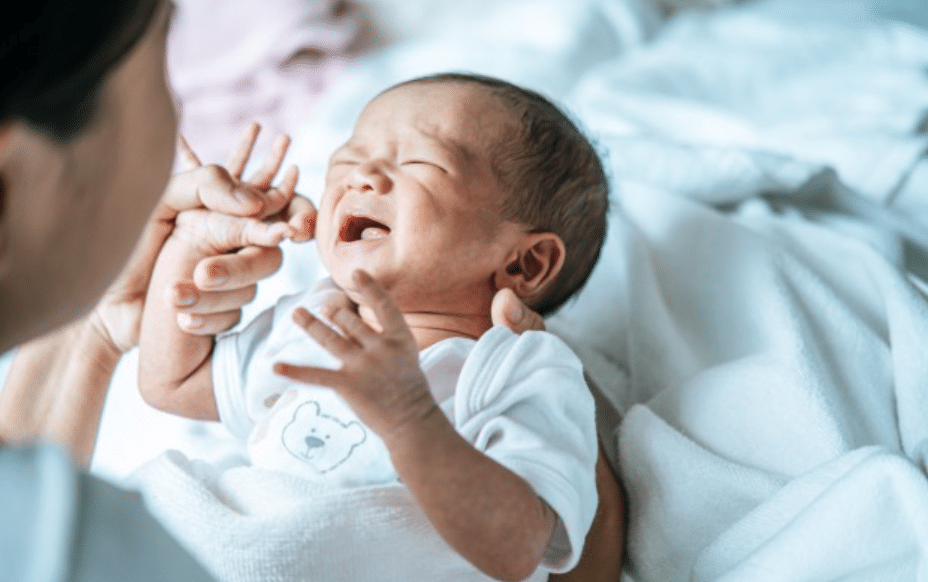Newborn jaundice is a very common phenomenon that occurs when the baby has a high level of bilirubin. Let’s take a closer look at it.
When a baby’s skin and eyes become yellow, we say that the baby has newborn jaundice. It is a very common ailment that many newborns experience. It usually occurs when the baby has high levels of bilirubin. This is a yellow pigment which is produced when the red blood cells of the body are broken down.
In older babies and also in adults, the liver is responsible for processing bilirubin. After the liver has processed it, it passes through the body’s intestinal tract. However, due to the fact that a newborn baby’s liver is not fully developed, in many cases it is not mature enough to remove the bilirubin.
On a more positive note, the good news is that in the majority of cases, this condition usually goes away without any sort of intervention as the baby’s liver develops and also as the baby slowly starts to feed. This helps the bilirubin to normally pass through the body.
When jaundice does appear, in most cases, it will disappear within a time frame of two to three weeks. If it lasts longer, there may be an underlying condition that is causing the jaundice. Moreover, if a baby has high levels of bilirubin, it may lead to other conditions. These conditions include things such as deafness, cerebral palsy and/or other forms of damage to the brain. It is recommended by doctors that all newborn babies should be tested for jaundice before they are discharged from the hospital. They need to be tested again when they are between 3 to 5 days old.
In This Article
Causes
There are specific criterias which point to the likelihood of a baby getting newborn jaundice. These include babies who are premature, babies who are not getting enough of their mother’s milk and babies who have incompatible blood type with the mother,
Some of the other causes of newborn jaundice include the following:
- Bruising during birth or other types of internal bruising
- Problems with the liver
- Infections
- Deficiency of enzyme
- Abnormality of the red blood cells
Symptoms
The first symptoms of newborn jaundice is the yellowing of the baby’s skin and also eyes. This can happen anywhere within the first 2 to 4 days of birth. It can start in the face before it spreads down to other parts of the body. The bilirubin levels usually are at the highest point between 3 to 7 days after being born. A good way to test if a baby has the condition is to lightly press on the skin of the baby. If the result of the press is that the area of the skin becomes yellow, then it is very likely that the baby has jaundice.
While most of the cases related to newborn jaundice are pretty normal, it can sometimes be an indicator that the baby has some other underlying condition. If it gets too serious, the jaundice also possesses the risk of passing the bilirubin into the brain. This can cause permanent damage to the brain.
It will be wise to contact your doctor if the following are applicable to your baby:
There is a spread of the jaundice or it becomes more pronounced
Fever exceed 100 degrees Fahrenheit
The yellowing really deepens
The baby feeds poorly, looks lethargic or makes cries that are high-pitched
Diagnosis
It is common practice for hospitals to discharge mothers within 72 hours of when their delivery occurred. Hence, it is vitally important that parents bring their babies in for checkups a few days after the birth has occurred.
A very specific and distinct yellow coloring of the skin and eyes confirm if a baby has jaundice. Additional tests may still be necessary, however, in order to determine how severe the jaundice is.
If the baby develops jaundice within the first 24 hours, then their bilirubin levels should be immediately monitored. This can be done either through a test on the skin or blood. Doctors may also need to perform additional tests in order to determine if there are any underlying conditions that caused the jaundice.
Treatment
If the jaundice is of the mild variety, then it should resolve on its own as the liver of the baby starts to mature. Make sure that the babies are fed frequently. This will ensure that the babies can pass bilirubin through their bodies.
Jaundice that is more serious may require other types of treatment. Phototherapy is a common and highly effective treatment for this condition. The way it works is that it uses light in order to break down the bilirubin that is present in the body of the baby. You may find more here.
During the process of phototherapy, your baby will normally be placed on a specially designed bed that is under a light that is emitting blue spectrum light. The baby will only be wearing a diaper and some specific goggles for the protection of their eyes. Sometimes, a fiber-optic blanket is placed underneath the baby.
In cases that are very severe and more serious, it may be necessary to get an exchange transfusion. This is when a baby receives small amounts of blood from a blood bank or a particular donor. The purpose of this is to replace the damaged blood of the baby with healthier blood. Another reason why this is done is because it increases the amount of red blood cells that are present in the baby’s body and it also reduces the overall bilirubin levels.
Newborn Jaundice, although pretty common and normal, should still be treated extremely seriously. This is why it is of utmost importance to carefully monitor your baby during the first five days of his/her life and to watchout for any of the above mentioned symptoms of jaundice. If you notice any symptoms, get in touch with your doctor as soon as possible.










![Home Renovation Guide [2025]](/app/uploads/2021/04/design-hacks-1-378x300.jpg)
